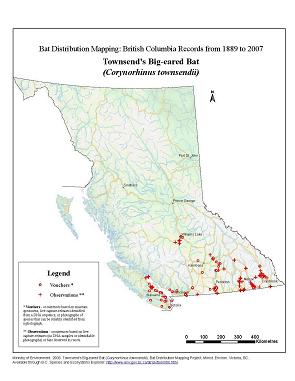Mating takes place from November to February, usually at the winter roost. Males do not breed in their first autumn; but yearling females can breed in their first year, usually giving birth later in the season than older females. A single young is born after a pregnancy of 50 to 100 days. The gestation period is controlled largely by temperature. Cool temperatures will induce torpor in pregnant females and slow down the development of the foetus. In coastal areas the young are probably born in June. When the Vancouver Island nursery colony was examined on 7 July it contained young at various stages of development: some were still nursing and others were capable of flying. The few breeding data available for the interior are limited to the southern Okanagan Valley. A pregnant female was captured on 3 July and a nursing female on 24 July, suggesting that young are born in mid July. At birth, the young weigh about 2.4 grams, their eyes are closed and the ears are not erect. Young Townsend's Big-eared Bats mature quickly; by three weeks they are capable of flying and at four weeks they are nearly adult size.
|
A late flyer, Townsend's Big-eared Bat emerges an hour or so after dark. It is an agile bat that is capable of flying at slow speeds. Food habits have not been studied in British Columbia. In the western United States, small moths (body length, 3-10 mm) form most of the diet. It also eats lacewings, dung beetles, flies and sawflies. This species feeds several times during the night - it is often near dawn before it returns to the day roost.
|
In the western United States, Townsend's Big-eared Bat uses caves, old mines and buildings as summer day roosts, with buildings being used more often in humid coastal areas. It uses similar situations for night roosts. Although Leo Jobin reported this species using old mine shafts near Williams Lake in summer, other researchers did not find it in any caves or mines during recent summer bat inventories in British Columbia.
Females form colonies of a dozen to several hundred in dimly lit areas in buildings, caves or mines. The only nursery colony found in British Columbia was in the attic of a house on Vancouver Island; it consisted of about 60 females and their young. Females and their young form tightly packed clusters that prevent heat loss and ensure the rapid development of the young. This species is particularly sensitive to human disturbance and a number of biologists have noted that females will permanently abandon a traditional summer roost if disturbed. Males roost alone during summer, separate from females.
In August, nursery colonies break up and individuals begin to migrate to caves and mine adits for hibernation. Townsend's Big-eared Bat is relatively sedentary, moving 10 to 65 kilometres between the summer roost and the winter hibernaculum. This is one of the few bats that has been consistently found hibernating in British Columbia. On the coast, there is a hibernaculum in a cave on Thetis Island that supports a population of 20 to 40 Townsend's Big-eared Bats each winter. The temperature in the cave is usually 8-10°C. In the interior, small hibernating colonies (up to 16 individuals) have been found in mines and caves from the Okanagan Valley to the Williams Lake region. In these interior hibernacula, this species usually occupies dry, exposed locations near the mine entrances where the temperatures are 5-8°C. But, in a survey of potential hibernacula conducted in the central interior in February 1990, several Townsend's Big-eared Bats were discovered hibernating in an ambient temperature of -4°C in an old mine shaft on the north shore of Kamloops Lake and a single bat was hibernating in an exposed tunnel of a limestone cave near Williams Lake where the temperature was -7°C. These observations were made a few days after a severe cold spell; they indicate that populations living at the northern limits of the range may tolerate periods of freezing temperatures.
Torpid Townsend's Big-eared Bats have been found in caves or mines from 16 September to 23 May. When in a state of deep torpor this bat hangs from a horizontal surface by its feet; its ears are curled back along the head in a shape resembling a ram's horn. Folding the ears may reduce heat loss. Curiously, the tragus remains erect when the ears are folded-it has been suggested that the tragus acts as a heat sensor. By the end of hibernation, Townsend's Big-eared Bat may have lost more than half its autumn weight. This species frequently arouses from hibernation in response to temperature changes or disturbance - it will change its position within a hibernaculum or even move to another cave or mine site in mid winter. These movements contribute to the severe weight loss, and they place a heavy demand on this bat's limited energy reserves.
|
|
